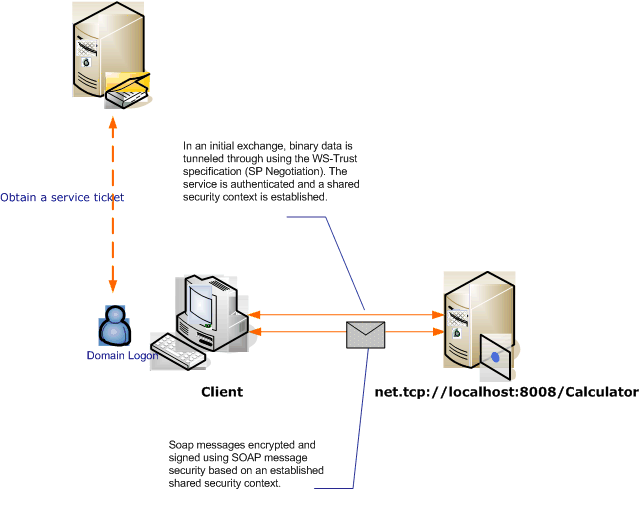Zabezpieczanie komunikatów za pomocą klienta systemu Windows
W tym scenariuszu przedstawiono klienta i serwer programu Windows Communication Foundation (WCF) zabezpieczonego przez tryb zabezpieczeń komunikatów. Klient i usługa są uwierzytelniane przy użyciu poświadczeń systemu Windows.

| Characteristic | opis |
|---|---|
| Tryb zabezpieczeń | Komunikat |
| Współdziałanie | Tylko program WCF |
| Uwierzytelnianie (serwer) | Wzajemne uwierzytelnianie serwera i klienta |
| Uwierzytelnianie (klient) | Wzajemne uwierzytelnianie serwera i klienta |
| Integralność | Tak, przy użyciu kontekstu zabezpieczeń udostępnionych |
| Poufność | Tak, przy użyciu kontekstu zabezpieczeń udostępnionych |
| Transport | NETTO. TCP |
| Wiązanie | NetTcpBinding |
Usługa
Poniższy kod i konfiguracja mają być uruchamiane niezależnie. Wykonaj jedną z następujących czynności:
Utwórz autonomiczną usługę przy użyciu kodu bez konfiguracji.
Utwórz usługę przy użyciu podanej konfiguracji, ale nie zdefiniuj żadnych punktów końcowych.
Kod
Poniższy kod pokazuje, jak utworzyć punkt końcowy usługi, który używa zabezpieczeń komunikatów do ustanowienia bezpiecznego kontekstu z maszyną z systemem Windows.
// Create the binding.
NetTcpBinding binding = new NetTcpBinding();
binding.Security.Mode = SecurityMode.Message;
binding.Security.Message.ClientCredentialType =
MessageCredentialType.Windows;
// Create the URI for the endpoint.
Uri netTcpUri = new Uri("net.tcp://localhost:8008/Calculator");
// Crate the service host and add an endpoint.
ServiceHost myServiceHost = new ServiceHost
(typeof(Calculator), netTcpUri);
myServiceHost.AddServiceEndpoint(
typeof(ICalculator), binding, "");
// Open the service.
myServiceHost.Open();
Console.WriteLine("Listening ....");
Console.ReadLine();
// Close the service.
myServiceHost.Close();
' Create the binding.
Dim binding As New NetTcpBinding()
binding.Security.Mode = SecurityMode.Message
binding.Security.Message.ClientCredentialType = MessageCredentialType.Windows
' Create the URI for the endpoint.
Dim netTcpUri As New Uri("net.tcp://localhost:8008/Calculator")
' Crate the service host and add an endpoint.
Dim myServiceHost As New ServiceHost(GetType(ServiceModel.Calculator), netTcpUri)
myServiceHost.AddServiceEndpoint(GetType(ICalculator), binding, "")
' Open the service.
myServiceHost.Open()
Console.WriteLine("Listening ....")
Console.ReadLine()
' Close the service.
myServiceHost.Close()
Konfigurowanie
Poniższa konfiguracja może służyć zamiast kodu do konfigurowania usługi:
<?xml version="1.0" encoding="utf-8"?>
<configuration>
<system.serviceModel>
<services>
<service behaviorConfiguration=""
name="ServiceModel.Calculator">
<endpoint address="net.tcp://localhost:8008/Calculator"
binding="netTcpBinding"
bindingConfiguration="Windows"
name="WindowsOverMessage"
contract="ServiceModel.ICalculator" />
</service>
</services>
<bindings>
<netTcpBinding>
<binding name="Windows">
<security mode="Message">
<message clientCredentialType="Windows" />
</security>
</binding>
</netTcpBinding>
</bindings>
<client />
</system.serviceModel>
</configuration>
Klient
Poniższy kod i konfiguracja mają być uruchamiane niezależnie. Wykonaj jedną z następujących czynności:
Utwórz klienta autonomicznego przy użyciu kodu (i kodu klienta).
Utwórz klienta, który nie definiuje żadnych adresów punktów końcowych. Zamiast tego użyj konstruktora klienta, który przyjmuje nazwę konfiguracji jako argument. Na przykład:
CalculatorClient cc = new CalculatorClient("EndpointConfigurationName");Dim cc As New CalculatorClient("EndpointConfigurationName")
Kod
Poniższy kod tworzy klienta. Powiązanie dotyczy zabezpieczeń trybu komunikatów, a typ poświadczeń klienta jest ustawiony na Windowswartość .
// Create the binding.
NetTcpBinding myBinding = new NetTcpBinding();
myBinding.Security.Mode = SecurityMode.Message;
myBinding.Security.Message.ClientCredentialType =
MessageCredentialType.Windows;
// Create the endpoint address.
EndpointAddress ea = new
EndpointAddress("net.tcp://machineName:8008/Calculator");
// Create the client.
CalculatorClient cc =
new CalculatorClient(myBinding, ea);
// Begin using the client.
try
{
cc.Open();
Console.WriteLine(cc.Add(200, 1111));
Console.ReadLine();
// Close the client.
cc.Close();
}
' Create the binding.
Dim myBinding As New NetTcpBinding()
myBinding.Security.Mode = SecurityMode.Message
myBinding.Security.Message.ClientCredentialType = MessageCredentialType.Windows
' Create the endpoint address.
Dim ea As New EndpointAddress("net.tcp://machineName:8008/Calculator")
' Create the client.
Dim cc As New CalculatorClient(myBinding, ea)
' Begin using the client.
Try
cc.Open()
Console.WriteLine(cc.Add(100, 11))
Console.ReadLine()
' Close the client.
cc.Close()
Catch tex As TimeoutException
Console.WriteLine(tex.Message)
cc.Abort()
Catch cex As CommunicationException
Console.WriteLine(cex.Message)
cc.Abort()
Finally
Console.WriteLine("Closed the client")
Console.ReadLine()
End Try
Konfigurowanie
Poniższa konfiguracja służy do ustawiania właściwości klienta.
<?xml version="1.0" encoding="utf-8"?>
<configuration>
<system.serviceModel>
<bindings>
<netTcpBinding>
<binding name="NetTcpBinding_ICalculator" >
<security mode="Message">
<message clientCredentialType="Windows" />
</security>
</binding>
</netTcpBinding>
</bindings>
<client>
<endpoint address="net.tcp://machineName:8008/Calculator"
binding="netTcpBinding"
bindingConfiguration="NetTcpBinding_ICalculator"
contract="ICalculator"
name="NetTcpBinding_ICalculator">
</endpoint>
</client>
</system.serviceModel>
</configuration>